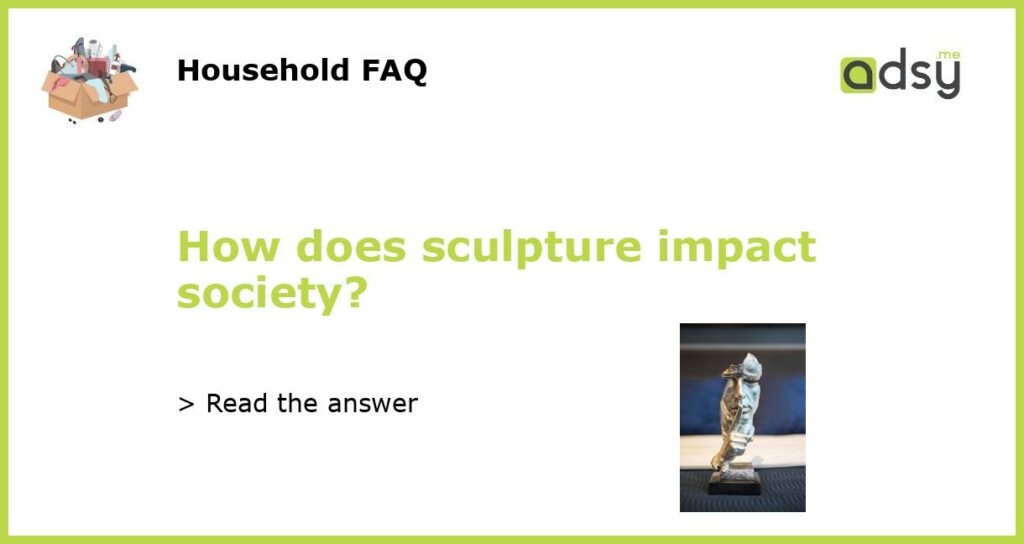Sculpture has been a significant form of artistic expression for centuries, influencing society in various ways. Whether it is a larger-than-life monument in a public park or a small sculpture displayed in a museum, sculptures have the power to evoke emotions, tell stories, and provoke thought. In this article, we will explore the impact of sculpture on society, examining its ability to shape culture, convey political messages, preserve history, inspire creativity, and foster a sense of community.
Shaping Culture
Sculpture plays a vital role in shaping culture by reflecting the values, beliefs, and traditions of a society. Throughout history, sculptures have been created to commemorate significant events, honor influential figures, and depict cultural symbols. For example, the Statue of Liberty in the United States represents freedom and democracy, becoming a symbol of American culture that has inspired millions of people worldwide. Similarly, sculptures of religious figures in churches and temples reflect the spiritual beliefs and practices of different cultures.
Sculpture also has the power to challenge cultural norms and provoke new ways of thinking. Contemporary artists often use sculpture as a medium for social commentary, addressing issues such as gender inequality, racial discrimination, and environmental concerns. These thought-provoking sculptures can spark conversations, challenge societal biases, and encourage cultural change.
Conveying Political Messages
Sculpture has long been used as a medium for conveying political messages and ideologies. From ancient civilizations to modern-day societies, public sculptures have been erected to commemorate leaders, celebrate victories, and reinforce political ideologies. For example, the massive sculptures of dictators like Saddam Hussein in Iraq or Kim Il-sung in North Korea serve as propaganda tools that promote a specific political agenda and reinforce the ruler’s authority.
Public sculptures can also be used to memorialize historical events and foster a sense of national identity. War memorials and monuments dedicated to fallen soldiers not only honor their sacrifice but also remind society of the devastation of war and the importance of peace. These sculptures often evoke powerful emotions and serve as a reminder of the impact of political decisions on society as a whole.
Preserving History
One of the significant contributions of sculpture to society is its ability to preserve history. Sculptures can depict historical figures, events, and cultural practices, acting as visual records of the past. Ancient sculptures, such as the Venus de Milo or the Rosetta Stone, provide valuable insights into the customs, beliefs, and artistic techniques of ancient civilizations.
In addition to ancient history, sculptures also preserve more recent events and individuals. Busts and statues of influential leaders, scientists, artists, and thinkers enshrine their contributions, ensuring that their legacies are not forgotten. These sculptures serve as reminders of society’s progress and provide inspiration for future generations.
Inspiring Creativity
Sculpture has a profound impact on inspiring creativity in individuals and society as a whole. The three-dimensional nature of sculptures allows viewers to explore different perspectives, encouraging them to think critically and engage with the artwork. Sculptures often challenge traditional notions of form, material, and space, pushing artists to experiment with new techniques and materials.
Sculpture also inspires creativity in other areas, such as design, architecture, and fashion. The innovative use of materials, textures, and shapes in sculptures can inspire architects to create daring buildings, designers to craft unique clothing, and artists to explore new artistic mediums. By pushing the boundaries of creativity, sculpture contributes to the overall development of artistic practices in society.
Fostering a Sense of Community
Sculptures are often placed in public spaces, transforming them into communal areas that foster a sense of belonging and community. Public sculptures serve as meeting points, landmarks, and gathering spaces for people, creating a shared sense of identity and pride in a specific location. These sculptures become a part of people’s daily lives and contribute to the overall beauty and aesthetics of a city or town.
Public sculptures also have the power to bring people together and encourage social interaction. They provide a backdrop for public events, festivals, and celebrations, creating a sense of unity and shared experience. The presence of sculptures in public spaces can strengthen community bonds, promote tourism, and enhance the overall quality of life for residents.
Sculpture has a profound impact on society, shaping culture, conveying political messages, preserving history, inspiring creativity, and fostering a sense of community. Whether through monumental public sculptures or smaller, intimate pieces displayed in museums, sculptures have the power to provoke thought, elicit emotions, and challenge societal norms. As a timeless form of artistic expression, sculpture continues to influence society and contribute to its development and evolution.






